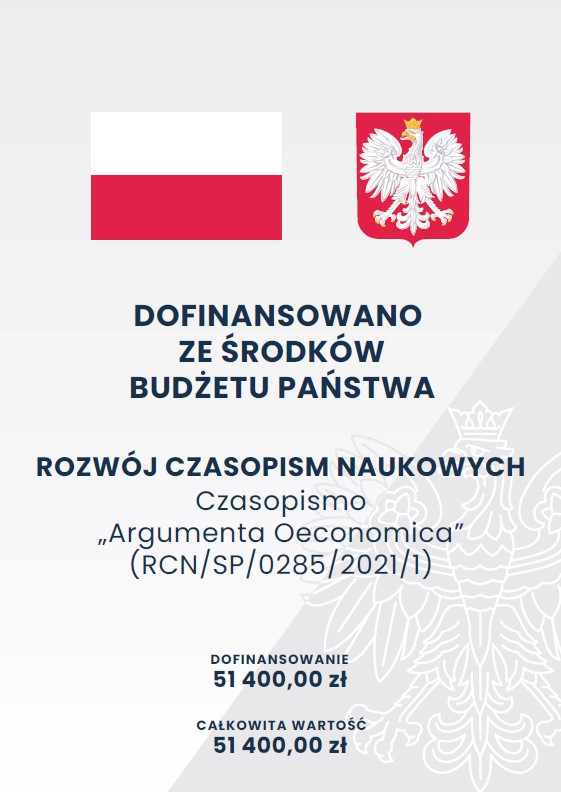The use of transitive Montgomery indicators for scanner data analysis
Keywords:
scanner data, Montgomery indicators, transitivity, multilateral indicatorsAbstract
Although the modern price index theory is based on an analysis of ratios of prices and quantities, one may be often more interested in working with differences in these values in many economic areas, e.g.: revenue change decompositions, profit and cost change decompositions, or an analysis of changes in consumer surplus. The benefit of using these differences is that there is no problem associated with the occurrence of zero prices and quantities, a problem that arises when working with ratios. In practice, one mostly cares about decomposing the value difference into indicators of contributions from price and quantity differences. The well-known price and quantity indicators are the Bennet and the Montgomery indicators, which are not transitive. This paper revises the price and quantity Montgomery indicators and their multilateral versions for the analysis of scanner data. Specifically, instead of considering ‘classical’ comparisons across firms, countries or regions, the transitive versions of the Montgomery indicators were adapted to work on scanner data sets observed over a fixed time window. One of the objectives of the study was to compare bilateral and multilateral Montgomery indicator values for different data aggregation levels and three main types of data filters. To the best of the authors’ knowledge, this study is pioneering on the grounds of implementing the multilateral Montgomery indicators in scanner data analysis.
Downloads
References
Balk, B. M., Färe, R. & Grosskopf, S. (2004). The theory of economic price and quantity indicators. Economic Theory, 23, 149-164. https://doi.org/10.1007/s00199-003-0364-5
Bennet, T. L. (1920). The theory of measurement of changes in cost of living. Journal of the Royal Statistical Society, 83(3), 455-462. https://doi.org/10.2307/2340960
Białek, J. (2021). Price indices – a new R package for bilateral and multilateral price index calculations. Statistika – Statistics and Economy Journal, 36(2), 122-141.
Białek, J. (2022). Scanner data processing in a newest version of the PriceIndices package. Statistical Journal of the IAOS, 38(4), 1369-1397. https://doi.org/10.3233/sji-220963
Białek, J., & Roszko-Wójtowicz, E. (2023). Potential reasons for CPI chain drift bias while using electronic transaction data. Technological and Economic Development of Economy, 29(2), 564-590. https://doi.org/10.3846/tede.2023.18467
Chambers, R. G. (2001). Consumers’ surplus as an exact and superlative cardinal welfare indicator. International Economic Review, 42(1), 105-119. https://doi.org/10.1111/1468-2354.00102
Chessa, A. (2015). Towards a generic price index method for scanner data in the Dutch CPI. The 14th meeting of the Ottawa Group, Tokyo, 20-22 May 2015. https://stats.unece.org/ottawagroup/download/f412.pdf
Chessa, A. G. (2016). A new methodology for processing scanner data in the Dutch CPI. Eurostat Review of National Accounts and Macroeconomic Indicators, 1(2016), 49-69.
Cross, R. M. & Färe, R. (2009). Value data and the Bennet price and quantity indicators. Economics Letters, 102(1), 19-21. https://doi.org/10.1016/j.econlet.2008.10.003
De Boer, P., & Rodrigues, J. F. (2020). Decomposition analysis: When to use which method? Economic Systems Research, 32(1), 1-28. https://doi.org/10.1080/09535314.2019.1652571
Diewert, W. E. (2005). Index number theory using differences rather than ratios. American Journal of Economics and Sociology, 64(1), 311-360. https://doi.org/10.1111/j.1536-7150.2005.00365.x
Diewert, W. E. (1976). Exact and superlative index numbers. Journal of Econometrics, 4(2), 115-145. https://doi.org/10.1016/0304-4076(76)90009-9
Diewert, W. E., & Mizobuchi, H. (2009). Exact and superlative price and quantity indicators. Macroeconomics Dynamics, 13(2), 335-380. https://doi.org/10.1017/s136510050909018x
Eltetö, O., & Köves, P. (1964). On a problem of index number computation relating to international comparison. Statisztikai Szemle, 42(10), 507-518.
Eurostat (2022). Guide on multilateral methods in the harmonised index of consumer prices. Publications Office of the European Union.
Fisher, I. (1922). The making of index numbers: A study of their varieties, tests, and reliability (No. 1). Houghton Mifflin Company, 1923 [c1922].
Fox, K. J. (2006). A method for transitive and additive multilateral comparisons: A transitive Bennet indicator. Journal of Economics, 87, 73-87. https://doi.org/10.1007/s00712-005-0160-8
Gini, C. (1931). On the circular test of index numbers. Metron, 9(9), 3-24.
International Labour Office (2004). Consumer price index manual: Theory and practice. Geneva.
International Monetary Fund (2020). Consumer price index manual: Concepts and methods. Washington, D.C.
Ivancic, L., Diewert, W. E., & Fox, K. J. (2011). Scanner data, time aggregation and the construction of price indexes. Journal of Econometrics, 161(1), 24-35. https://doi.org/10.1016/j.jeconom.2010.09.003
Konüs, A. A. (1939). The problem of the true index of the cost of living. Econometrica: Journal of the Econometric Society, 10-29.
Montgomery, J. K. (1929). Is there a theoretically correct price index of a group of commodities? L’Universale Tipogr. Poliglotta
Montgomery, J. K. (1937). The mathematical problem of the price index, Orchard House. P.S. King & Son.
Szulc, B. (1964). Indices for multiregional comparisons. Przegląd Statystyczny, 3, 239-254.
Van Loon, K. & Roels, D. (2018, May). Integrating big data in the Belgian CPI. Meeting of the group of experts on consumer price indices (pp. 7-9).
Vartia, Y. O. (1976). Ideal log-change index numbers. Scandinavian Journal of Statistics, 3, 121-126.
Von der Lippe, P. (2007). Index theory and price statistics. Peter Lang Verlag. https://doi.org/10.3726/978-3-653-01120-3
Downloads
Published
License
Copyright (c) 2024 Jacek Białek, Natalia Pawelec

This work is licensed under a Creative Commons Attribution-ShareAlike 4.0 International License.
Accepted 2023-11-22
Published 2024-12-03








